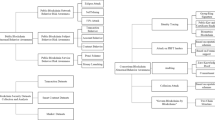Abstract
With the increasing use of Blockchain, community has become increasingly worried about its security, that has led to substantial research by academics, with anomaly detection being a major issue. Regardless of the fact that they can provide availability and integrity, the bulk of public Blockchain systems are decentralized and have minimal confidentiality. The Blockchain network is vulnerable to transaction privacy breaches since all of the network's keys are exposed to everyone. Various security flaws in Ethereum and smart contracts have recently been discovered. As a result, it's critical to improve Blockchain’s security features. This research will mainly use the literature survey method and the inductive analysis method to analyze the relevant research works for anomaly detection in Blockchain technology and to find out the trends and characteristics of the development and application of the anomaly detection models and explore its feasibility in ensuring security in Blockchain technology. This paper also proposes a framework for anomaly detection in Blockchain technology.
Access this chapter
Tax calculation will be finalised at checkout
Purchases are for personal use only
Similar content being viewed by others
References
Bodkhe U et al (2020) Blockchain for Industry 4.0: a comprehensive review. IEEE Access 8:79764–79800. https://doi.org/10.1109/ACCESS.2020.2988579
Salah K, Rehman MHU, Nizamuddin N, Al-Fuqaha A (2019) Blockchain for AI: review and open research challenges. IEEE Access 7:10127–10149. https://doi.org/10.1109/ACCESS.2018.2890507
Franciscon EA, Nascimento MP, Granatyr J, Weffort MR, Lessing OR, Scalabrin EE (2019) A systematic literature review of blockchain architectures applied to public services. In: 2019 IEEE 23rd international conference on computer supported cooperative work in design (CSCWD), pp 33–38. https://doi.org/10.1109/CSCWD.2019.8791888
Tahir M, Habaebi MH, Dabbagh M, Mughees A, Ahad A, Ahmed KI (2020) A review on application of blockchain in 5G and beyond networks: taxonomy, field-trials, challenges and opportunities. IEEE Access 8:115876–115904. https://doi.org/10.1109/ACCESS.2020.3003020
Ahmed M, Mahmood AN, Hu J (2016) A survey of network anomaly detection techniques. J Netw Comput Appl 60:19–31
Yu Y, Li Y, Tian J, Liu J (2018) Blockchain-based solutions to security and privacy issues in the internet of things. IEEE Wirel Commun 25(6):12–18. https://doi.org/10.1109/MWC.2017.1800116
Dai F, Shi Y, Meng N, Wei L, Ye Z (2017) From bitcoin to cybersecurity: a comparative study of blockchain application and security issues. In: 2017 4th international conference on systems and informatics (ICSAI), pp 975–979. https://doi.org/10.1109/ICSAI.2017.8248427
Huynh TT, Nguyen TD, Tan H (2019) A survey on security and privacy issues of blockchain technology. In: 2019 international conference on system science and engineering (ICSSE), pp 362–367. https://doi.org/10.1109/ICSSE.2019.8823094
Meng W, Tischhauser EW, Wang Q, Wang Y, Han J (2018) When intrusion detection meets blockchain technology: a review. IEEE Access 6:10179–10188. https://doi.org/10.1109/ACCESS.2018.2799854
Alexopoulos N, Vasilomanolakis E, Ivanko NR, Muhlhauser M (2017) Towards blockchain-based collaborative intrusion detection systems. In: Proceedings of international conference on critical information infrastructures security, pp 1–12
Xing Z, Chen Z (2021) A protecting mechanism against double spending attack in blockchain systems. In: 2021 IEEE world AI IoT congress (AIIoT), pp 0391–0396. https://doi.org/10.1109/AIIoT52608.2021.9454224
John R, Cherian JP, Kizhakkethottam JJ (2015) A survey of techniques to prevent sybil attacks. In: 2015 international conference on soft-computing and networks security (ICSNS), pp 1–6. https://doi.org/10.1109/ICSNS.2015.7292385
Gupta KD, Rahman A, Poudyal S, Huda MN, Mahmud MAP (2019) A hybrid POW-POS implementation against 51 percent attack in cryptocurrency system. In: 2019 IEEE international conference on cloud computing technology and science (CloudCom), pp 396–403. https://doi.org/10.1109/CloudCom.2019.00068
Andryukhin AA (2019) Phishing attacks and preventions in blockchain based projects. In: 2019 international conference on engineering technologies and computer science (EnT), pp 15–19. https://doi.org/10.1109/EnT.2019.00008
Wang X, WeiLi J, Chai J (2018) The research on the incentive method of consortium blockchain based on practical byzantine fault tolerant. In: 2018 11th international symposium on computational intelligence and design (ISCID), pp 154–156. https://doi.org/10.1109/ISCID.2018.10136
Perazzo P, Arena A, Dini G (2020) An analysis of routing attacks against IOTA cryptocurrency. In: 2020 IEEE international conference on blockchain (Blockchain), pp 517–524. https://doi.org/10.1109/Blockchain50366.2020.00075
Morishima S (2021) Scalable anomaly detection in blockchain using graphics processing unit. Comput Electr Eng 92:107087. https://doi.org/10.1016/j.compeleceng.2021.107087. ISSN 0045-7906
Maskey SR, Badsha S, Sengupta SS, Khalil I (2021) ALICIA: applied Intelligence in blockchain based VANET: accident validation as a case study. Inf Process Manag 58(3):102508. https://doi.org/10.1016/j.ipm.2021.102508. ISSN 0306-4573
Hu T, Liu X, Chen T, Zhang X, Huang X, Niu W, Lu J, Zhou K, Liu Y (2021) Transaction-based classification and detection approach for ethereum smart contract. Inf Process Manag 58(2):102462. https://doi.org/10.1016/j.ipm.2020.102462. ISSN 0306-4573
Zhang M, Xu B, Gong J (2015) An anomaly detection model based on one-class SVM to detect network intrusions. In: 2015 11th international conference on mobile ad-hoc and sensor networks (MSN), pp 102–107. https://doi.org/10.1109/MSN.2015.40
Martin K, Rahouti M, Ayyash M, Alsmadi I (2021) Anomaly detection in blockchain using network representation and machine learning. Secur Priv e192
Patel V, Pan L, Rajasegarar S (2020) Graph deep learning based anomaly detection in ethereum blockchain network. In: Kutyłowski M, Zhang J, Chen C (eds) Network and system security. NSS 2020. Lecture notes in computer science, vol 12570. Springer, Cham
Wang X, He J, Xie Z, Zhao G, Cheung S-C (2020) ContractGuard: defend ethereum smart contracts with embedded intrusion detection. IEEE Trans Serv Comput 13(2):314–328
Author information
Authors and Affiliations
Corresponding author
Editor information
Editors and Affiliations
Rights and permissions
Copyright information
© 2023 The Author(s), under exclusive license to Springer Nature Singapore Pte Ltd.
About this paper
Cite this paper
Sanjay Rai, G., Goyal, S.B., Chatterjee, P. (2023). Anomaly Detection in Blockchain Using Machine Learning. In: Chatterjee, P., Pamucar, D., Yazdani, M., Panchal, D. (eds) Computational Intelligence for Engineering and Management Applications. Lecture Notes in Electrical Engineering, vol 984. Springer, Singapore. https://doi.org/10.1007/978-981-19-8493-8_37
Download citation
DOI: https://doi.org/10.1007/978-981-19-8493-8_37
Published:
Publisher Name: Springer, Singapore
Print ISBN: 978-981-19-8492-1
Online ISBN: 978-981-19-8493-8
eBook Packages: Intelligent Technologies and RoboticsIntelligent Technologies and Robotics (R0)




